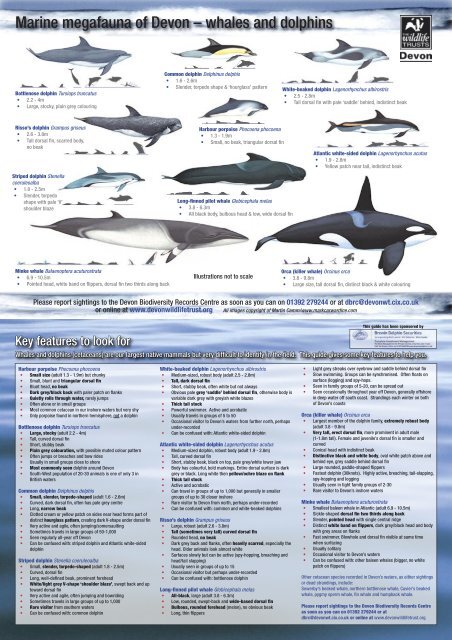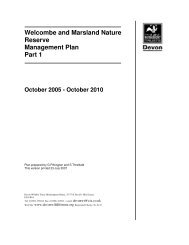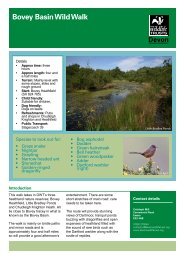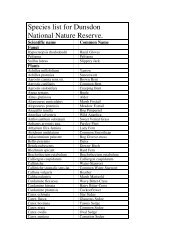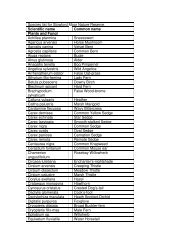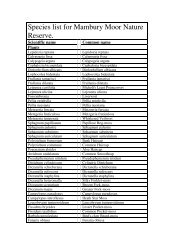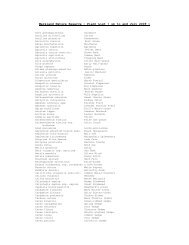Marine Megafauna Guide - Devon Wildlife Trust
Marine Megafauna Guide - Devon Wildlife Trust
Marine Megafauna Guide - Devon Wildlife Trust
You also want an ePaper? Increase the reach of your titles
YUMPU automatically turns print PDFs into web optimized ePapers that Google loves.
<strong>Marine</strong> megafauna of <strong>Devon</strong> – whales and dolphins<br />
Bottlenose dolphin Tursiops truncatus<br />
• 2.2 - 4m<br />
• Large, stocky, plain grey colouring<br />
Risso’s dolphin Grampus griseus<br />
• 2.6 - 3.8m<br />
• Tall dorsal fin, scarred body,<br />
no beak<br />
Striped dolphin Stenella<br />
coeruleoalba<br />
• 1.8 - 2.5m<br />
• Slender, torpedo<br />
shape with pale ‘V’<br />
shoulder blaze<br />
Minke whale Balaenoptera acuturostrata<br />
• 6.9 - 10.5m<br />
• Pointed head, white band on flippers, dorsal fin two thirds along back<br />
Common dolphin Delphinus delphis<br />
• 1.6 - 2.6m<br />
• Slender, torpedo shape & ‘hourglass’ pattern<br />
Harbour porpoise Phocoena phocoena<br />
• 1.3 - 1.9m<br />
• Small, no beak, triangular dorsal fin<br />
Long-finned pilot whale Globicephala melas<br />
• 3.8 - 6.3m<br />
• All black body, bulbous head & low, wide dorsal fin<br />
Illustrations not to scale<br />
White-beaked dolphin Lagenorhynchus albirostris<br />
• 2.5 - 2.8m<br />
• Tall dorsal fin with pale ‘saddle’ behind, indistinct beak<br />
Atlantic white-sided dolphin Lagenorhynchus acutus<br />
• 1.9 - 2.8m<br />
• Yellow patch near tail, indistinct beak<br />
Orca (killer whale) Orcinus orca<br />
• 3.8 - 9.8m<br />
• Large size, tall dorsal fin, distinct black & white colouring<br />
Please report sightings to the <strong>Devon</strong> Biodiversity Records Centre as soon as you can on 01392 279244 or at dbrc@devonwt.cix.co.uk<br />
or online at www.devonwildlifetrust.org All images copyright of Martin Camm/www.markcarwardine.com<br />
Key features to look for<br />
Whales and dolphins (cetaceans) are our largest native mammals but very difficult to identify in the field. This guide gives some key features to help you.<br />
Harbour porpoise Phocoena phocoena<br />
• Small size (adult 1.3 - 1.9m) but chunky<br />
• Small, blunt and triangular dorsal fin<br />
• Blunt head, no beak<br />
• Dark grey/black back with paler patch on flanks<br />
• Quietly rolls through water, rarely jumps<br />
• Often alone or in small groups<br />
• Most common cetacean in our inshore waters but very shy<br />
• Only porpoise found in northern hemisphere, not a dolphin<br />
Bottlenose dolphin Tursiops truncatus<br />
• Large, stocky (adult 2.2 - 4m)<br />
• Tall, curved dorsal fin<br />
• Short, stubby beak<br />
• Plain grey colouration, with possible muted colour pattern<br />
• Often jumps or breaches and bow rides<br />
• Usually in small groups close to shore<br />
• Most commonly seen dolphin around <strong>Devon</strong><br />
• South-West population of 20-30 animals is one of only 3 in<br />
British waters<br />
Common dolphin Delphinus delphis<br />
• Small, slender, torpedo-shaped (adult 1.6 - 2.6m)<br />
• Curved, dark dorsal fin, often has pale grey centre<br />
• Long, narrow beak<br />
• Clotted cream or yellow patch on sides near head forms part of<br />
distinct hourglass pattern, creating dark V-shape under dorsal fin<br />
• Very active and agile, often jumping/somersaulting<br />
• Sometimes travels in large groups of 50-1,000<br />
• Seen regularly all-year off <strong>Devon</strong><br />
• Can be confused with: striped dolphin and Atlantic white-sided<br />
dolphin<br />
Striped dolphin Stenella coeruleoalba<br />
• Small, slender, torpedo-shaped (adult 1.8 - 2.5m)<br />
• Curved, dorsal fin<br />
• Long, well-defined beak, prominent forehead<br />
• White/light grey V-shape ‘shoulder blaze’, swept back and up<br />
toward dorsal fin<br />
• Very active and agile, often jumping and bowriding<br />
• Sometimes travels in large groups of up to 1,000<br />
• Rare visitor from southern waters<br />
• Can be confused with: common dolphin<br />
White-beaked dolphin Lagenorhynchus albirostris<br />
• Medium-sized, robust body (adult 2.5 - 2.8m)<br />
• Tall, dark dorsal fin<br />
• Short, stubby beak, often white but not always<br />
• Obvious pale grey ‘saddle’ behind dorsal fin, otherwise body is<br />
variable dark grey with greyish white blazes<br />
• Thick tail stock<br />
• Powerful swimmer. Active and acrobatic<br />
• Usually travels in groups of 5 to 50<br />
• Occasional visitor to <strong>Devon</strong>’s waters from further north, perhaps<br />
under-recorded<br />
• Can be confused with: Atlantic white-sided dolphin<br />
Atlantic white-sided dolphin Lagenorhynchus acutus<br />
• Medium-sized dolphin, robust body (adult 1.9 - 2.8m)<br />
• Tall, curved dorsal fin<br />
• Short, stubby beak, black on top, pale grey/white lower jaw<br />
• Body has colourful, bold markings. Entire dorsal surface is dark<br />
grey or black. Long white then yellow/ochre blaze on flank<br />
• Thick tail stock<br />
• Active and acrobatic<br />
• Can travel in groups of up to 1,000 but generally in smaller<br />
groups of up to 30 closer inshore<br />
• Rare visitor to <strong>Devon</strong> from north, perhaps under-recorded<br />
• Can be confused with: common and white-beaked dolphins<br />
Risso’s dolphin Grampus griseus<br />
• Large, robust (adult 2.6 - 3.8m)<br />
• Tall (sometimes very tall) curved dorsal fin<br />
• Rounded head, no beak<br />
• Dark grey back and flanks, often heavily scarred, especially the<br />
head. Older animals look almost white<br />
• Surfaces slowly but can be active (spy-hopping, breaching and<br />
head/tail slapping)<br />
• Usually seen in groups of up to 15<br />
• Occasional visitor but perhaps under-recorded<br />
• Can be confused with: bottlenose dolphin<br />
Long-finned pilot whale Globicephala melas<br />
• All-black, large (adult 3.8 - 6.3m)<br />
• Low, rounded, swept-back and wide-based dorsal fin<br />
• Bulbous, rounded forehead (melon), no obvious beak<br />
• Long, thin flippers<br />
This guide has been sponsored by<br />
• Light grey streaks over eyebrow and saddle behind dorsal fin<br />
• Slow swimming. Groups can be synchronised. Often floats on<br />
surface (logging) and spy-hops.<br />
• Seen in family groups of 5-20, can be spread out<br />
• Seen occasionally throughout year off <strong>Devon</strong>, generally offshore<br />
in deep water off south coast. Strandings each winter on both<br />
of <strong>Devon</strong>’s coasts<br />
Orca (killer whale) Orcinus orca<br />
• Largest member of the dolphin family, extremely robust body<br />
(adult 3.8 - 9.8m)<br />
• Very tall, erect dorsal fin, more prominent in adult male<br />
(1-1.8m tall). Female and juvenile’s dorsal fin is smaller and<br />
curved<br />
• Conical head with indistinct beak<br />
• Distinctive black and white body, oval white patch above and<br />
behind eye, grey saddle behind dorsal fin<br />
• Large rounded, paddle-shaped flippers<br />
• Fastest dolphin (30knots). Highly active, breaching, tail-slapping,<br />
spy-hopping and logging<br />
• Usually seen in tight family groups of 2-30<br />
• Rare visitor to <strong>Devon</strong>’s inshore waters<br />
Minke whale Balaenoptera acuturostrata<br />
• Smallest baleen whale in Atlantic (adult 6.9 - 10.5m)<br />
• Sickle-shaped dorsal fin two thirds along back<br />
• Slender, pointed head with single central ridge<br />
• Distinct white band on flippers, dark grey/black head and body<br />
with grey areas on flanks<br />
• Fast swimmer. Blowhole and dorsal fin visible at same time<br />
when surfacing<br />
• Usually solitary<br />
• Occasional visitor to <strong>Devon</strong>’s waters<br />
• Can be confused with: other baleen whales (bigger, no white<br />
patch on flippers)<br />
Other cetacean species recorded in <strong>Devon</strong>’s waters, as either sightings<br />
or dead strandings, include:<br />
Sowerby’s beaked whale, northern bottlenose whale, Cuvier’s beaked<br />
whale, pygmy sperm whale, fin whale and humpback whale.<br />
Please report sightings to the <strong>Devon</strong> Biodiversity Records Centre<br />
as soon as you can on 01392 279244 or at<br />
dbrc@devonwt.cix.co.uk or online at www.devonwildlifetrust.org
<strong>Marine</strong> megafauna of <strong>Devon</strong> – seals & summer visitors<br />
Grey seal Halichoerus grypus<br />
• 2.1 - 3.3m<br />
• Flat profile, male even has hooked nose, nostrils parallel,<br />
blotchy coat<br />
Leatherback turtle Dermochelys coriacea<br />
• Up to 3m long<br />
• Ridged soft shell, black with white spots<br />
Dustbin lid, barrel or root<br />
mouth jellyfish<br />
Rhizostoma octopus<br />
• Up to 1m across<br />
• Solid, rubbery bell<br />
and thick, frilled arms.<br />
Please report sightings to the <strong>Devon</strong> Biodiversity Records Centre as soon as you can on 01392 279244 or at dbrc@devonwt.cix.co.uk<br />
or online at www.devonwildlifetrust.org All images copyright of Martin Camm/www.markcarwardine.com<br />
<strong>Marine</strong> megafauna of <strong>Devon</strong><br />
Grey seal Halichoerus grypus<br />
• Large seal (adult 2.1 - 3.3m)<br />
• Head has flat profile ie straight line from top of head to nose. In<br />
male exaggerated to give a hooked or ‘Roman nose’<br />
• Variable grey coat is covered in thick blotches, unique to<br />
each animal. Male usually dark with lighter blotches and female<br />
light with dark blotches.<br />
• Nostrils parallel to one another, not always obvious<br />
• Usually seen in rocky areas, but also in estuaries and bays<br />
• Year round <strong>Devon</strong> resident. Do not usually occur much further up<br />
Channel than <strong>Devon</strong><br />
• Breeds on <strong>Devon</strong> beaches, pups are white<br />
• South-West population of grey seals is globally important<br />
Common or harbour seal Phoca vitulina<br />
• Smaller seal (adult 1.2 - 1.9m)<br />
• Muzzle short and concave. Face has dog-like appearance<br />
• Coat has mottled pattern of spots, varies in colour from light<br />
grey to dark brown<br />
• Nostrils joined at base in ‘V’ shape<br />
• Frequents sandbanks in estuaries but also occurs on rocky coasts<br />
• Occasional visitor to <strong>Devon</strong> from East England<br />
Basking shark Cetorhinus maximus<br />
• Second largest fish in world (adult to 11m)<br />
• Large, angular dorsal fin<br />
• Pointed snout over cavernous mouth (white inside)<br />
• Swims slowly at surface, feeding<br />
• Often see snout, dorsal and tail fin together on surface<br />
• Seen most often in summer<br />
Leatherback turtle Dermochelys coriacea<br />
• Largest turtle in world (adult to 3m)<br />
• Distinctive, soft shell with longitudinal ridges<br />
• Black with white spots<br />
• When at surface only back and sometimes head visible<br />
Other species of sharks and turtles, as well as large fish - such as<br />
sunfish, Mola mola, do frequent <strong>Devon</strong>’s waters.<br />
All the jellyfish you are likely to encounter in <strong>Devon</strong>’s waters are<br />
illustrated above.<br />
Compass jellyfish<br />
Chrysaora hysoscella<br />
• Up to 30cm across<br />
• V-shaped markings on<br />
bell look like compass<br />
points. Stings.<br />
DO NOT TOUCH<br />
Blue jellyfish<br />
Cyanea lamarckii<br />
• Up to 30cm across<br />
• Blue bell with<br />
radial lines.<br />
Mild sting<br />
Mauve stinger Pelagia noctiluca<br />
• Up to 10cm across<br />
• Deep bell with small ‘warts’,<br />
glows at night. Strong sting.<br />
DO NOT TOUCH<br />
Common or harbour seal Phoca vitulina<br />
• 1.2 - 1.9m<br />
• ‘Dog-like’ face, V-shaped<br />
nostrils (joined at base)<br />
and spotty coat<br />
By-the-wind-sailor Velella velella<br />
• Up to 10cm across<br />
• Upright ‘sail’, blue-purple colour,<br />
occurs in vast swarms<br />
Top tips for marine megafauna (mega=big,<br />
fauna=animals) sightings:<br />
• Calm, still days with high cloud are best<br />
• Circling and diving birds indicate shoals of fish, these attract<br />
dolphins and porpoises<br />
• Cliff tops, headlands and boats provide the best views<br />
What to do if you see a large marine animal?<br />
ALL sightings are important, however uncertain. Please report any<br />
to the <strong>Devon</strong> Biodiversity Records Centre (DBRC) as soon as you<br />
can, on 01392 279244 or at dbrc@devonwt.cix.co.uk or online at<br />
www.devonwildlifetrust.org with the following information:<br />
• what you saw (photos, video or a description are<br />
invaluable)<br />
• where you saw it/them<br />
• when you saw it/them (include time)<br />
• who you are (name/address/email/phone)<br />
• how certain you are of the identification<br />
• how many you saw<br />
• what it/they were doing<br />
Plus, any other details eg weather, animal’s condition including<br />
marks or scars etc<br />
If you would like to learn more, become a regular dolphin surveyor<br />
or have marine mammal records to give, please contact DBRC.<br />
Data Protection Act<br />
All the information you provide will be added to the DBRC database. <strong>Wildlife</strong><br />
information from this database may be passed on to third parties (eg Seawatch<br />
Foundation, <strong>Marine</strong> Conservation Society) for conservation and management<br />
purposes, or displayed on websites for educational purposes. Personal details<br />
(apart from names) will NOT be passed on without prior permission being given<br />
by the individual. Please contact us if you have any objections to this.<br />
Moon jellyfish Aurelia aurita<br />
• Up to 40cm across<br />
• 4 rings in bell, short<br />
tentacles. Mild sting<br />
Basking shark Cetorhinus maximus<br />
• Up to 11m long<br />
• Large dorsal fin, snout and mouth. Snout , dorsal and<br />
tail fin often seen at same time on surface<br />
Portuguese man-of-war<br />
Physalia physalis<br />
• Float is up to 30cm long<br />
• Gas-filled float, very long<br />
trailing<br />
tentacles. Strong sting.<br />
DO NOT TOUCH<br />
Illustrations<br />
not to scale<br />
Code of conduct<br />
Whales, dolphins and porpoises are highly intelligent animals<br />
and vessels can disturb, hit and injure them.<br />
If they approach your boat or bow-ride, maintain a slow speed<br />
and course until clear. When watching dolphins, always let them<br />
decide what happens.<br />
Please follow these guidelines:<br />
• Keep your distance. Never go closer than 100m (200m if<br />
another boat is present)<br />
• Never drive head on to, or move between, scatter or<br />
separate dolphins. If unsure of their movements simply<br />
stop<br />
• Do not chase or harass them<br />
• Always allow a clear escape route for them<br />
• Move away slowly if they show signs of disturbance<br />
• Spend no longer than 15 minutes near the animals<br />
• Avoid mothers with youngsters<br />
• Maintain a steady direction and slow ‘no wake’ speed<br />
• Don’t call other vessels to the area<br />
• Never try to swim with cetaceans for your safety and<br />
theirs<br />
Cetaceans and basking sharks are protected by law making it<br />
illegal to disturb or harass them. Report all incidents to the<br />
Police (08452 777444).<br />
Purpose of ID guide<br />
This ID <strong>Guide</strong> has been produced by the <strong>Devon</strong> <strong>Wildlife</strong> <strong>Trust</strong> as part of the<br />
Dolphin Protection Programme, which aims to monitor cetacean numbers in<br />
<strong>Devon</strong>’s waters, and identify their habits and hotspots for conservation. The<br />
Dolphin Protection Programme works with all cetacean recording organisations<br />
including Seaquest South-West and the Seawatch Foundation and is supported<br />
by Brewin Dolphin Securities.


